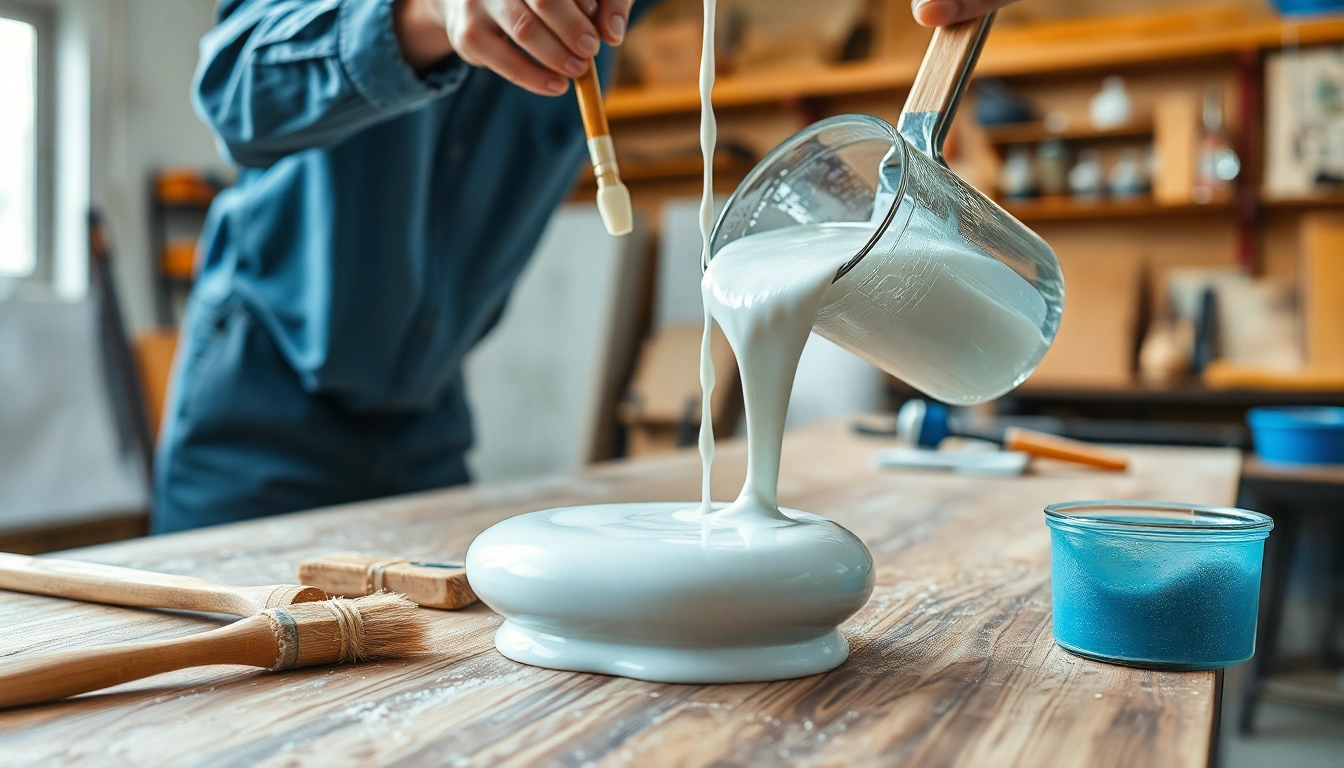Understanding Infusion Resins and Their Applications
Infusion resins are specially formulated materials that play a crucial role in composite manufacturing processes. They provide an efficient means to enhance the structural integrity and performance characteristics of various materials. Infusion resins can be utilized for a spectrum of applications across multiple industries, paving the way for advanced composite constructions. By exploring infusion resins, we can delve into their definitions, benefits, and numerous applications.
What Are Infusion Resins?
Infusion resins are low-viscosity thermosetting polymers used primarily in the vacuum infusion process. This manufacturing method involves drawing resin into a dry fabric laminate under vacuum conditions, allowing for a complete filling of the fibers with resin. The resin hardens upon curing, resulting in a durable composite material. These resins are engineered to deliver a balance of strength, clarity, and controlled flow, making them ideal for lightweight yet strong applications.
Key Benefits of Using Infusion Resins
- High Strength-to-Weight Ratio: Infusion resins create composites that are both lightweight and structurally sound, a characteristic highly valued in aerospace and automotive applications.
- Reduced VOC Emissions: Many modern infusion resins are designed to have lower volatile organic compound (VOC) emissions, contributing to a more environmentally friendly manufacturing process.
- Controlled Flow and Curing: The low viscosity of infusion resins allows for better penetration into the fibers of the laminate, ensuring even distribution of the material, which ultimately leads to superior mechanical properties.
- Surface Finish: Infusion processes typically result in better surface finishes due to the absence of air pockets or voids, leading to higher quality final products.
Common Applications for Infusion Resins
The versatility of infusion resins allows for application in various sectors. Here are some notable examples:
- Aerospace: Used for fabricating lightweight and robust aircraft components, infusion resins aid in enhancing fuel efficiency.
- Marine: Boat hulls, decks, and other components are constructed using infusion resins to promote longevity and resistance to water damage.
- Automotive: Infusion resins are integral to manufacturing composite parts that require high strength and low weight, optimizing vehicle performance.
- Wind Energy: The renewable energy sector employs infusion resins in the production of wind turbine blades, which benefit from the resins’ strength and durability.
Choosing the Right Infusion Resins for Your Project
Factors to Consider When Selecting Infusion Resins
Various factors contribute to the selection of appropriate infusion resins for specific projects. The following considerations can guide your decision-making process:
- Viscosity: The viscosity of the resin dictates how well it flows into the fiber architecture. Lower viscosity resins can better penetrate fine fibers.
- Cure Time: Understanding how quickly a resin cures is critical for operational efficiency. Some projects may require quicker curing times than others.
- Thermal Properties: When choosing infusion resins, it is essential to consider the thermal resistance required for the application, especially in environments exposed to high temperatures.
- Compatibility: Ensure that the chosen resin is compatible with the reinforcement materials, such as carbon or glass fibers, to avoid delamination issues.
Comparing Different Types of Infusion Resins
Infusion resins are available in different formulations, including epoxy, polyester, and vinyl ester. Each type has unique properties suited to particular applications:
- Epoxy Resins: Known for their superior mechanical properties and low shrinkage, epoxy resins are often preferred in high-performance applications.
- Polyester Resins: Often more cost-effective, polyester resins have higher shrinkage rates and are typically used in applications where ultimate performance is not the primary focus.
- Vinyl Ester Resins: These resins provide enhanced corrosion resistance and are found in marine applications where exposure to water and chemicals is common.
How to Match Infusion Resins to Specific Requirements
Aligning your project requirements with the properties of specific infusion resins can significantly enhance production efficiency and end-product performance. Here’s how to make the right match:
- Define the end-use environment of the composite material. Consider factors such as exposure to heat, moisture, and chemicals.
- Evaluate the required mechanical properties such as tensile strength and modulus.
- Prioritize processing conditions including cure times and temperatures.
- Consider budget constraints and the cost-effectiveness of the resin types available.
Techniques for Utilizing Infusion Resins
Step-by-Step Guide to the Infusion Process
Implementing the vacuum infusion process requires meticulous preparation and execution. Below is a basic guide:
- Prepare the mold: Ensure the mold is clean and properly sealed to prevent any resin spillage.
- Lay-up reinforcement: Place the dry fabric reinforcement in the mold, ensuring the direction and layering meet design specifications.
- Implement vacuum bagging: Cover the lay-up with a vacuum bag, sealing it tightly to create an airtight environment.
- Connect the infusion lines: Integrate resin inlet and vacuum outlet lines to prepare for the infusion.
- Infuse the resin: Activate the vacuum to draw the resin into the mold; monitor the infusion process until completion.
- Allow for curing: Once infused, let the resin cure based on its specific cure schedule.
- Demold the part: Once fully cured, remove the part from the mold and conduct post-curing if necessary.
Best Practices for Optimal Results with Infusion Resins
To maximize the effectiveness of infusion resins, consider the following best practices:
- Ensure proper mold preparation: The success of the infusion process hinges on the quality of the mold.
- Monitor temperature and humidity: Environmental conditions can affect resin behavior; keep them within specified limits.
- Pre-wet fabrics: Pre-wetting the reinforcement fabrics with a small amount of resin prior to the vacuum can improve infusion quality.
- Conduct test infusions: Testing small-scale samples can help identify any issues before full-scale production.
Troubleshooting Common Issues During Resin Infusion
Common challenges may arise during the infusion process. Understanding how to resolve these can ensure a successful operation:
- Dry spots: Occur when the resin fails to completely saturate the reinforcement. Solutions include adjusting the vacuum levels and improving resin flow paths.
- Air pockets: Result from improper sealing or disruption during infusion. Ensuring complete vacuum sealing before infusion starts can mitigate this.
- Inconsistent cure: Variances in temperature or resin mixture can lead to cure failure. Check all mixing protocols and environmental conditions thoroughly.
Evaluating the Performance of Infusion Resins
Testing Methods for Infusion Resins
Performance evaluation is critical for ensuring that the infusion resins meet design specifications and standards.
Standard testing methods can include:
- Tensile Testing: Used to assess the ultimate tensile strength of the cured resin.
- Flexural Testing: Measures the resin’s response to bending forces.
- Thermal Analysis: Differential scanning calorimetry (DSC) and thermogravimetric analysis (TGA) help evaluate the thermal properties of the cured material.
Measuring Strength and Durability of Infusion Resins
Understanding the mechanical properties of infusion resins is vital for predicting performance under operational conditions. Key properties to measure include:
- Tensile Strength: Indicates the maximum stress the material can withstand when being pulled or stretched.
- Compressive Strength: Determines how much load the resin can support when compressed.
- Impact Resistance: Assesses the ability of the resin to withstand sudden forces or impacts without failure.
Comparative Analysis of Performance Data
Conducting comparative analyses of different infusion resins under similar testing conditions can yield insights into material selection:
- Compare the tensile and flexural strengths of different resin applications to find the best fit for specific needs.
- Review the thermal properties of various infusion resins to determine which will perform best in elevated temperature environments.
- Analyze long-term durability through accelerated aging tests to predict how materials will perform over time under normal use conditions.
Future Trends in Infusion Resins Technology
Innovations in Infusion Resins for Sustainable Practices
The push for sustainability has spurred continuous innovations in resin technology. Future trends include:
- Bio-based Resins: Development of resins derived from renewable resources aims to reduce reliance on petroleum-based products.
- Recyclable Composites: Research into resins that allow for easier recycling can significantly impact environmental sustainability.
- Low-Emission Formulations: Innovations aimed at reducing emissions during the manufacturing process are becoming increasingly significant for regulatory compliance.
Emerging Technologies Supporting Infusion Resins Development
New technologies continually enhance resin production and application methods, including:
- Smart Manufacturing: Integration of IoT sensors can monitor and optimize resin infusion processes in real-time.
- Advanced Automation: Robotics and automation technologies are improving the precision of resin lay-up and curing processes, increasing efficiency and reducing human error.
Predicted Market Trends for Infusion Resins
As industries evolve, infusion resins will likely see a surge in demand due to:
- Growing Aerospace Industry: Increasing global air travel and the demand for fuel-efficient aircraft require advanced composite materials.
- Expanding Renewable Energy Sector: The necessity for high-performance components in solar and wind energy applications will drive the infusion resin market.
- Automotive Electrification: The shift towards electric vehicles, requiring lightweight materials for extended range, will bolster the use of infusion resins.



